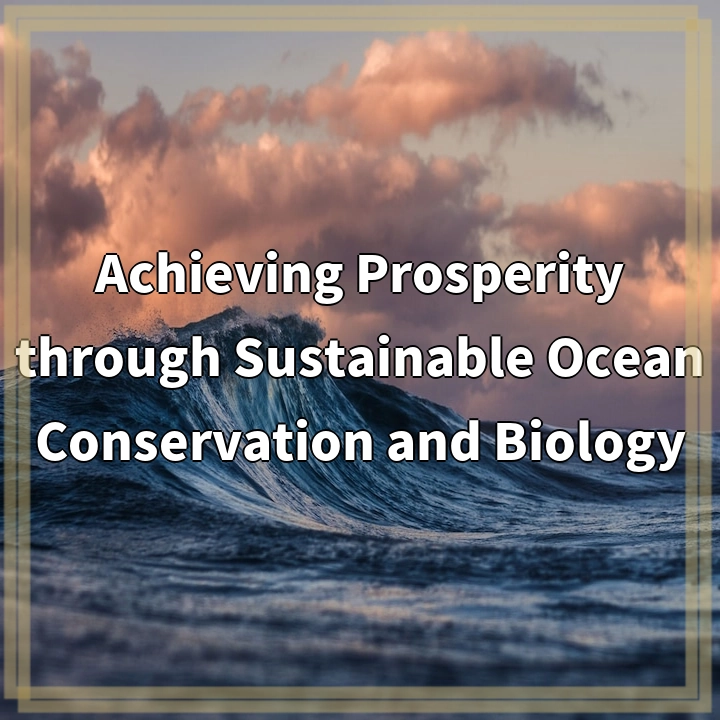
What is Achieving Prosperity through Sustainable Ocean Conservation and Biology?
Sustainable ocean conservation and biology is a comprehensive approach to protect and preserve the oceans while promoting economic prosperity and sustainable development. It aims to find a balance between utilizing the resources of the ocean and ensuring their long-term health and viability. This approach recognizes that the ocean plays a vital role in various aspects of our lives, including food security, climate regulation, and economic opportunities.
Real-world Problems Associated with Achieving Prosperity through Sustainable Ocean Conservation and Biology
1. Overfishing and Depleted Fish Stocks: One of the major challenges in achieving sustainable ocean conservation is the overexploitation of fish stocks. Many regions worldwide face declining fish populations due to excessive fishing, leading to ecological imbalances and impacting the livelihoods of communities reliant on fishing.
2. Pollution and Plastic Waste: Ocean pollution, including plastic waste, poses a significant threat to marine life and ecosystems. Discarded plastics can harm marine animals through ingestion or entanglement, and chemical pollutants can contaminate water and pose health risks to aquatic organisms and humans.
3. Habitat Destruction: Coastal development, destructive fishing practices, and climate change contribute to the destruction of vital marine habitats like coral reefs, mangroves, and seagrasses. These habitats provide crucial breeding grounds, nurseries, and protection for numerous marine species.
4. Climate Change and Ocean Acidification: Rising global temperatures and increased carbon dioxide emissions lead to climate change and ocean acidification. These factors negatively impact marine life, including coral bleaching, disruption of food webs, and the loss of biodiversity.
5. Unsustainable Aquaculture: While aquaculture has the potential to provide sustainable seafood, improper practices such as high-density fish farming, poor waste management, and the use of antibiotics can lead to pollution and disease outbreaks, posing risks to wild populations and ecosystems.
6. Lack of Regulation and Enforcement: In many regions, weak or ineffective regulatory frameworks and inadequate enforcement hamper efforts for sustainable ocean conservation. Lack of cooperation between countries and limited resources further hinder addressing these challenges effectively.
7. Limited Public Awareness and Engagement: Achieving prosperity through sustainable ocean conservation and biology requires widespread awareness and engagement from the public, policymakers, and various stakeholders. Enhancing public understanding, education, and community involvement is crucial for positive change.
8. Socioeconomic Imbalances: Achieving sustainability in ocean conservation requires addressing socioeconomic imbalances. Balancing economic development, job creation, and poverty alleviation with conservation efforts is essential to ensure that all communities benefit equitably from the sustainable use of ocean resources.

Solutions for Achieving Prosperity through Sustainable Ocean Conservation and Biology
1. Implementing Sustainable Fisheries Management
– Enforce strict fishing quotas and regulations to prevent overfishing and replenish depleted fish stocks.
– Promote sustainable fishing practices, such as selective fishing gear and responsible catch and release.
– Encourage the establishment of marine protected areas (MPAs) to safeguard critical habitats and allow fish populations to recover.
– Support small-scale fishers and local communities through alternative livelihood options and sustainable fishing practices.
2. Reducing Pollution and Plastic Waste
– Implement comprehensive waste management systems to prevent pollution from entering the oceans.
– Educate the public and raise awareness about the harmful impacts of plastic waste through campaigns and educational programs.
– Encourage the use of alternatives to single-use plastics and promote recycling and proper disposal.
– Support research and innovation in developing more sustainable packaging materials and waste management technologies.
3. Protecting and Restoring Marine Habitats
– Establish more marine protected areas (MPAs) and enforce their regulations to conserve and rehabilitate critical habitats.
– Implement sustainable coastal development practices that prioritize the protection of important ecosystems.
– Support restoration initiatives, such as coral reef restoration and mangrove rehabilitation projects.
– Incorporate ecosystem-based management approaches that consider the interconnectedness of marine habitats and species.
4. Addressing Climate Change and Ocean Acidification
– Reduce greenhouse gas emissions through transitioning to renewable energy sources and promoting energy efficiency.
– Mitigate the impacts of climate change on marine ecosystems through the implementation of adaptation and resilience strategies.
– Support research on climate change and ocean acidification to better understand and address their effects on marine life.
– Advocate for international agreements and policies that prioritize climate action and ocean conservation.
5. Promoting Sustainable Aquaculture Practices
– Encourage the adoption of responsible and sustainable practices in aquaculture, including proper waste management and disease prevention.
– Promote the use of environmentally friendly fish feed and reduce the reliance on wild fish stocks for feed production.
– Strengthen regulations and certification schemes to ensure the sustainability and traceability of aquaculture products.
– Support research and development of innovative and sustainable aquaculture technologies.
6. Strengthening Governance and Cooperation
– Improve international collaboration and cooperation to address transboundary issues and implement effective conservation measures.
– Enhance the capacity and resources of governmental and non-governmental organizations involved in ocean conservation.
– Develop and enforce robust regulations and policies to ensure sustainable practices and hold accountable those who violate them.
– Foster partnerships between various stakeholders, including scientists, policymakers, communities, and industry, to achieve shared goals.
7. Promoting Public Awareness and Engagement
– Conduct education and outreach programs to increase public awareness about the importance of ocean conservation and biology.
– Encourage individuals to make sustainable choices in their daily lives, such as reducing plastic consumption and supporting sustainable seafood options.
– Engage with local communities and indigenous peoples, respecting their traditional knowledge and involving them in decision-making processes.
– Promote citizen science initiatives to involve the public in collecting data and monitoring marine ecosystems.
8. Addressing Socioeconomic Imbalances
– Ensure that sustainable practices consider the social and economic well-being of communities, particularly those dependent on the ocean.
– Support capacity building and training programs to empower local communities and enhance their involvement in sustainable ocean management.
– Promote equitable access to resources and benefits, ensuring that all stakeholders can participate in and benefit from sustainable initiatives.
– Collaborate with businesses and investors to develop sustainable blue economy models that prioritize social and environmental goals.















